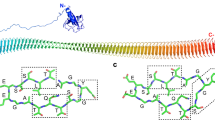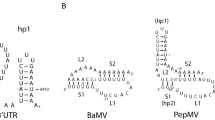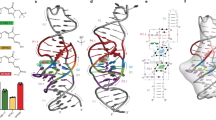Abstract
Nucleation of a physical process is distinct from catalysis, and as the function of a protein it is highly unusual. The ability to nucleate ice formation in supercooled water is a property of some members of the bacterial genera Erwinia, Pseudomonas and Xanthomonas1–3. This property is implicated in the ability of bacteria to cause frost injury to plants. Orser et al.4 have demonstrated that a single small region of DNA encodes this phenotype, and there is evidence that phosphatidylinositol is involved5. Biological ice nuclei are also found in the haemolymph of certain freeze-tolerant insects6. It is thought that an ice nucleation site must bind water molecules in an orderly array resembling an ice crystal. We have now determined the sequence of an ice nucleation gene from Pseudomonas syringae. It predicts a translation product whose structure is consistent with the role of template, containing 122 imperfect repeats of the consensus octapeptide Ala-Gly-Tyr-Gly-Ser-Thr-Leu-Thr. All the repeats are contiguous and higher-order periodicities are superimposed on the octapeptide pattern throughout. Deletion analysis showed that most regions of the repeating structure are not essential for function. Up to 68 octapeptides could be deleted without abolishing ice nucleation, but all deletions showed reduced activity. This indicates that the repeated peptides contribute individually to the nucleation process, as expected if they act as individual units of a water-binding array.
This is a preview of subscription content, access via your institution
Access options
Subscribe to this journal
Receive 51 print issues and online access
$199.00 per year
only $3.90 per issue
Buy this article
- Purchase on Springer Link
- Instant access to full article PDF
Prices may be subject to local taxes which are calculated during checkout
Similar content being viewed by others
References
Schnell, R. C. & Vali, C. Nature 236, 163–165 (1972).
Maki, L. R. et al. Appl. Microbiol. 28, 456–459 (1974).
Lindow, S. E., Arny, D. C. & Upper, C. D. Phytopathology 68, 523–527 (1978).
Orser, C. et al. in Molecular Genetics of the Bacteria-Plant Interaction (ed. Puehler, A.) 353–361 (Springer, New York, 1983).
Kozloff, L. M., Lute, M. & Westaway, D. Science 226, 845–846 (1984).
Duman, J. G. & Horwath, K. L. A. Rev. Physiol. 45, 261–270 (1983).
Vieira, J. & Messing, J. Gene 19, 259–268 (1982).
Maizel, J. M. & Lenk, R. P. Proc. natn. Acad. Sci. U.S.A. 78, 7665–7669 (1981).
Duman, J. G., Morris, J. P. & Castellino, F. J. J. comp. Physiol. B154, 79–83 (1984).
Messing, J. & Vieira, J. Gene 19, 269–276 (1982),
Winter, G. & Fields, S. D. Nucleic Acids Res. 8, 1965–1974 (1980).
Sanger, F., Nicklen, S. & Coulson, A. R. Proc. natn. Acad. Sci. U.S.A. 74, 5463–5467 (1977).
Sanger, F. & Coulson, A. R. FEBS Lett. 87, 107–110 (1978).
Author information
Authors and Affiliations
Rights and permissions
About this article
Cite this article
Green, R., Warren, G. Physical and functional repetition in a bacterial ice nucleation gene. Nature 317, 645–648 (1985). https://doi.org/10.1038/317645a0
Received:
Accepted:
Issue Date:
DOI: https://doi.org/10.1038/317645a0
This article is cited by
-
Survival and ice nucleation activity of Pseudomonas syringae strains exposed to simulated high-altitude atmospheric conditions
Scientific Reports (2019)
-
The study of atmospheric ice-nucleating particles via microfluidically generated droplets
Microfluidics and Nanofluidics (2018)
-
Biochemical characterization and identification of ice-nucleation-active (INA) willow pathogens by means of BIOLOG® MicroPlate, INA gene primers and PCR-based 16S rRNA-gene analyses
Journal of Plant Diseases and Protection (2006)
Comments
By submitting a comment you agree to abide by our Terms and Community Guidelines. If you find something abusive or that does not comply with our terms or guidelines please flag it as inappropriate.



